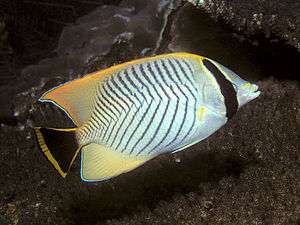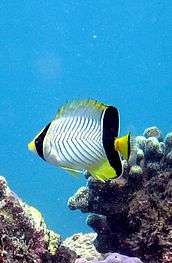Chevron butterflyfish
The chevron butterflyfish (Chaetodon trifascialis), also known as chevroned butterflyfish, triangulate butterflyfish or V-lined butterflyfish, is a species of butterflyfish (family Chaetodontidae) found in the Indo-Pacific from the Red Sea and East Africa to the Hawaiian and Society Islands.[2]
| Chevron Butterflyfish | |
|---|---|
 | |
| Adult | |
| Scientific classification | |
| Kingdom: | |
| Phylum: | |
| Class: | |
| Order: | |
| Family: | |
| Genus: | Chaetodon (but see text) |
| Subgenus: | |
| Species: | C. trifascialis |
| Binomial name | |
| Chaetodon trifascialis | |
Chevron butterflyfish should not be confused with Melon butterflyfish Chaetodon trifasciatus, Three-striped butterflyfish Chaetodon tricinctus, or Three-banded Butterflyfish.
Description
Adults have an elongate white body with narrow chevron markings and may be up to 18 cm (7 in) in length.[2] Juveniles have a mostly yellow tail and a broad black band extending from the rear of the dorsal fin to the rear of the anal fin. The tail pattern and the coloring of the posterior part of body changes dramatically with growth, with the tail entirely black with a thin yellow outline and the hind part of the body not differing in color from the areas further forward in adults.

With its peculiar age-dependent color and elongated outline, this species has been placed in a monotypic subgenus Megaprotodon. Its closest living relatives seem to be the species of the subgenera Discochaetodon (e.g. Eight-banded Butterflyfish, C. octofasciatus) and Tetrachaetodon (e.g. Mirror Butterflyfish, C. speculum). These, and perhaps other subgenera, would use Megaprotodon as genus name if Chaetodon is split up.[3][4]
Chaetodon trifascialis is a territorial species which occurs in semi-protected seaward and shallow lagoon reefs, closely associated with tabular and staghorn (Acropora) corals, the polyps and mucus of which they eat. They occur at depths ranging from 2–30 m. Adults are either seen to swim alone or (particularly in the breeding season) in pairs, while juveniles are secretive among coral branches. They are oviparous.[2]
References
- Carpenter, K.E. & Pratchett, M. (2009). "Chaetodon trifascialis". IUCN Red List of Threatened Species. 2009. Retrieved 12 April 2011.CS1 maint: ref=harv (link)
- FishBase (2008): Chaetodon trifascialis. Version of 2008-JUL-24. Retrieved 2008-SEP-01.
- Fessler, Jennifer L. & Westneat, Mark W. (2007): Molecular phylogenetics of the butterflyfishes (Chaetodontidae): Taxonomy and biogeography of a global coral reef fish family. Mol. Phylogenet. Evol. 45(1): 50–68. doi:10.1016/j.ympev.2007.05.018 (HTML abstract)
- Hsu, Kui-Ching; Chen, Jeng-Ping & Shao, Kwang-Tsao (2007): Molecular phylogeny of Chaetodon (Teleostei: Chaetodontidae) in the Indo-West Pacific: evolution in geminate species pairs and species groups. Raffles Bulletin of Zoology Supplement 14: 77-86. PDF fulltext Archived August 11, 2007, at the Wayback Machine
External links
- Photos of Chevron butterflyfish on Sealife Collection
| Wikimedia Commons has media related to Chaetodon trifascialis. |
